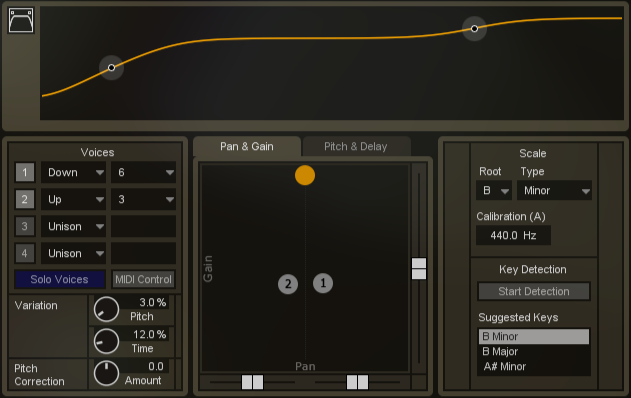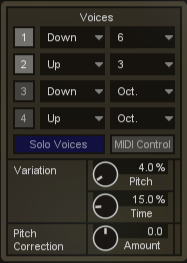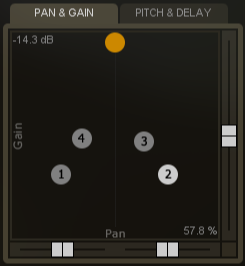
Nectar 2’s new Harmony module allows you to instantly add harmonized vocal accompaniments to your tracks without time-consuming tracking, multiple takes, and performers. Key Detection technology intelligently suggests the key of your song to allow for real-time harmonized voice generation.

Note: The Harmony module has replaced Nectar’s Doubler Module. The Harmony module will act as a doubler when all added voices are shifted either up or down an octave.
Voices
The Harmony module offers up to four vocal accompaniments, known as voices. Each voice may be in unison or shifted up/down intervals as large as an octave. To enable a voice, click its corresponding voice number to the left. Once enabled, you may select the direction and amount the voice is shifted relative to the lead voice or if it is in unison.
Solo Voices
Clicking Solo Voices mutes the lead vocal so the module only outputs added voices. This can be useful when placing Nectar on an aux track to process harmonies independently from your lead vocal.
MIDI Control
Enabling MIDI Control allows you to trigger backing voices with your MIDI Controller. When enabled, the voice table will dim, and the settings of added voices will be determined by the four nodes in the X/Y Pad discussed below. The first four voices triggered by your MIDI controller will have the settings of the four nodes in the X/Y Pad. After four voices are added, the settings in the X/Y Pad will be repeated for more than four voices.
Learn more about setting up MIDI Control here.

Pitch
Pitch Variation allows you to give each added voice its own subtle differences in pitch. This creates a humanizing effect to the added voices and reduces phase cancellation.
Time
Time Variation allows you to create varying time offsets in each added voice. This simulates multiple performances and reduces phase cancellation.
Pitch Correction
Determines the amount of pitch correction performed on the added vocal accompaniments. Values of 100% will be corrected while values of -100% will be further detuned.

Modes
The X/Y Pad features both Pan/Gain and Pitch/Delay modes. By default, the X/Y Pad displays Pan/Gain controls.
Pan & Gain
When in Pan/Gain mode, the Harmony module’s X/Y Pad allows you to quickly adjust the level and stereo placement of each added voice. Each added voice is represented on the X/Y Pad as a node labeled with its corresponding voice number.
Pitch & Delay
When in Pitch/Delay mode, the Harmony module’s X/Y Pad allows you to quickly fine-tune the pitch and adjust the offset/delay of each added voice. Each added voice is represented on the X/Y Pad as a node labeled with its corresponding voice number.
Here you can define the root note or key that your vocal takes are in. It is important to set an accurate Root Note as this can help the pitch correction algorithm determine the best possible pitches for added voices.
Chromatic
A scale in which every note of every octave will be available for added voices. If you are not sure of the scale that your vocal takes are in, be sure to set your scale type to Chromatic in order to get the best results.

Note: When in chromatic mode, as every pitched note is available for added voices, the defined root note has no effect.
Major / Minor / Custom
Here you can select to snap your outgoing harmonized voices to either a Major, Minor or Custom scale of your choosing based upon your specified Root Note. When defining a Custom scale, click one upon the notes of the keyboard you wish to enable as options for pitch correction. When the individual notes are enabled, they will turn gold or dark gold for black keys. White and black notes will be disabled and not used in pitch correction.
Reference Pitch (Hz)
By default, all pitches will be based upon a standard A = 440Hz tuning reference. If your audio is not based on this standard reference pitch, or has been moved slightly due to analog tape recording, you can adjust Nectar's reference Pitch here.
Start/Stop Detection
This button toggles Nectar’s Key Detection on and off. Click once to start detection and again when you feel you have accurate results. Generally, running detection for one verse and chorus of your song is sufficient.
Suggested Keys
Once Key Detection has started, this selection window will be populated with a prioritized list of suggested keys for your song. After Key Detection has been performed for an adequate period of time (usually one verse and chorus), you’ll find that the top three suggestions remain the same. Clicking the suggestions from the list will automatically change the Root and Key settings described above.
Mini-spectrum Display
 Each module of Nectar features a display of the frequency spectrum at the top for reference while making changes to your audio within the module. The Harmony module’s mini-spectrum includes both a high and low shelf filter that affect only the voices added by the Harmony module. These filters allow you to sculpt the added backing vocals independently of the lead voice.
Each module of Nectar features a display of the frequency spectrum at the top for reference while making changes to your audio within the module. The Harmony module’s mini-spectrum includes both a high and low shelf filter that affect only the voices added by the Harmony module. These filters allow you to sculpt the added backing vocals independently of the lead voice.
In Mixing Mode, Nectar’s Harmony module will make use of lookahead in order to provide the best results. However, this process requires a small amount of latency (delay). In Tracking Mode, the Harmony module will use very little latency to assist in tracking, but will be lower quality.